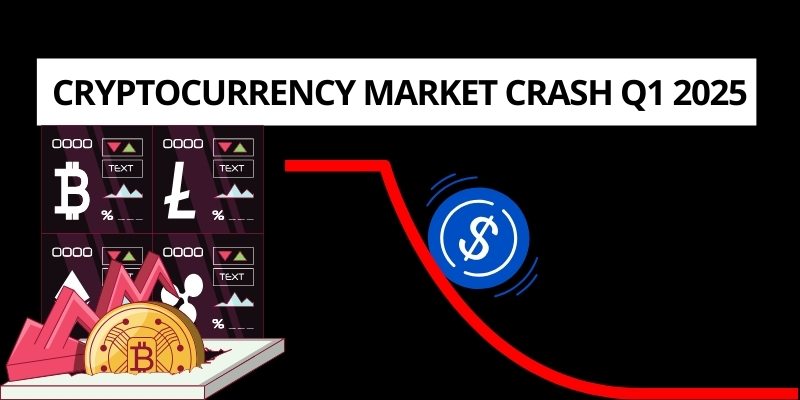The cryptocurrency market crash of Q1 2025, which saw a staggering $663 billion—18.6% of total market capitalization—wiped out, has cast a long shadow over the global crypto ecosystem. According to CoinGecko’s latest report, this dramatic decline was driven by a toxic mix of macroeconomic turbulence, regulatory ambiguity, and security failures. What began with bullish fervor in January, spurred by Donald Trump’s inauguration and expectations of pro-crypto policies, unraveled into a market-wide rout. This article dissects the anatomy of the cryptocurrency market crash, its far-reaching consequences, and the lessons investors must heed to navigate future volatility.
From Euphoria to Collapse: The Q1 Rollercoaster
The cryptocurrency market crash followed a fleeting period of optimism. January 2025 saw Bitcoin and altcoins rally, fueled by speculation that Trump’s administration would usher in crypto-friendly regulations. The Solana-based TRUMP meme coin epitomized this exuberance, briefly dominating trading volumes before crashing spectacularly. The LIBRA scandal, a murky affair that shook market confidence, compounded the downturn. By March, the market was in freefall, with CoinGecko reporting an 18.6% contraction in total capitalization, equivalent to $663 billion.

Bitcoin, which commands 59.1% of the market, was not immune, shedding 11.8% of its value. Ethereum suffered an even steeper decline, erasing all gains from 2024. The cryptocurrency market crash was particularly jarring because it outperformed traditional assets like gold and U.S. Treasury bonds in the wrong direction. Trump’s tariff policies, which disrupted global trade and depressed bond yields, created a risk-off environment that hit crypto hardest, exposing its vulnerability to macroeconomic shocks.
A Crisis of Confidence
The cryptocurrency market crash triggered a seismic shift in investor sentiment. Daily trading volumes plummeted by 27.3% from Q4 2024, signaling a retreat from active participation. Spot trading on centralized exchanges fell 16.3%, a decline partly attributed to the Bybit hack, which underscored persistent security risks. The decentralized finance (DeFi) sector, once a beacon of innovation, saw its total value locked (TVL) across multi-chain protocols drop by 27.5%. Solana, a DeFi powerhouse, lost over 20% of its TVL, reflecting the sector’s exposure to market volatility.
The cryptocurrency market crash was not just a price correction but a crisis of confidence. Investors, burned by unmet expectations and security breaches, adopted a cautious stance. The “sell-the-news” effect, driven by disillusionment with regulatory progress, fueled mass liquidations. Fears of a global recession, amplified by macroeconomic data, further dampened risk appetite, leaving the market in a state of paralysis.
Bright Spots in a Bleak Landscape
Amid the wreckage of the cryptocurrency market crash, a few sectors showed resilience. Bitcoin exchange-traded funds (ETFs) attracted $1 billion in new inflows, a testament to institutional confidence in the asset’s long-term value. Solana’s decentralized exchanges (DEXs) continued to lead the DeFi space, outperforming rivals despite the broader downturn. However, these positives were overshadowed by systemic challenges. Total assets under management (AUM) in crypto funds fell by nearly $9 billion due to declining prices, and ETF yields suffered as asset values cratered.

The cryptocurrency market crash highlighted the limitations of these bright spots. While ETF inflows signaled demand, the broader market’s decline eroded their impact. Solana’s DEX dominance, though impressive, could not offset the DeFi sector’s broader contraction. The market’s recovery will hinge on addressing these structural weaknesses while capitalizing on areas of strength.
The Catalysts Behind the Crash
The cryptocurrency market crash was the result of multiple converging factors. Trump’s tariffs destabilized global markets, creating a ripple effect that suppressed risk assets like crypto. The Bybit hack, one of the largest in recent years, exposed vulnerabilities in centralized exchanges, prompting outflows. Regulatory uncertainty, particularly around stablecoins and DeFi, added to the malaise. The LIBRA scandal, though details remain scarce, further eroded trust, amplifying the sell-off.
Macroeconomic fears, including the specter of a global recession, played a central role. Unlike previous cycles, where crypto rebounded quickly, the cryptocurrency market crash of Q1 2025 suggests a more protracted downturn. The market’s sensitivity to external shocks underscores the need for greater resilience, whether through improved security, regulatory clarity, or diversification.
Lessons for Investors
The cryptocurrency market crash offers critical lessons for investors. First, diversification is paramount. Overexposure to speculative assets, such as meme coins, proved disastrous in Q1. Second, security must be a priority. The Bybit hack highlighted the risks of centralized platforms, pushing investors toward decentralized alternatives. Third, macroeconomic awareness is essential. Policies like tariffs and interest rate shifts can profoundly impact crypto, necessitating a broader market perspective.
Finally, patience will be key. The cryptocurrency market crash may have dented confidence, but history shows that crypto often recovers from steep corrections. Investors should focus on assets with strong fundamentals, such as Bitcoin and Solana, while staying attuned to regulatory and economic developments. A disciplined approach, grounded in research and risk management, will be crucial for navigating the volatile road ahead.
Conclusion
The $663 billion cryptocurrency market crash in Q1 2025 marks a turning point for the crypto industry. What began as a year of promise descended into one of the most severe corrections in recent history, driven by macroeconomic disruptions, security breaches, and regulatory uncertainty. While Bitcoin ETFs and Solana’s DEXs offer glimmers of hope, the market’s recovery will require time, trust, and structural reforms. For investors, the crash is a call to action: stay informed, diversify, and approach the market with caution and conviction. The crypto landscape remains dynamic, and those who learn from this downturn will be best positioned to thrive in its next chapter.

